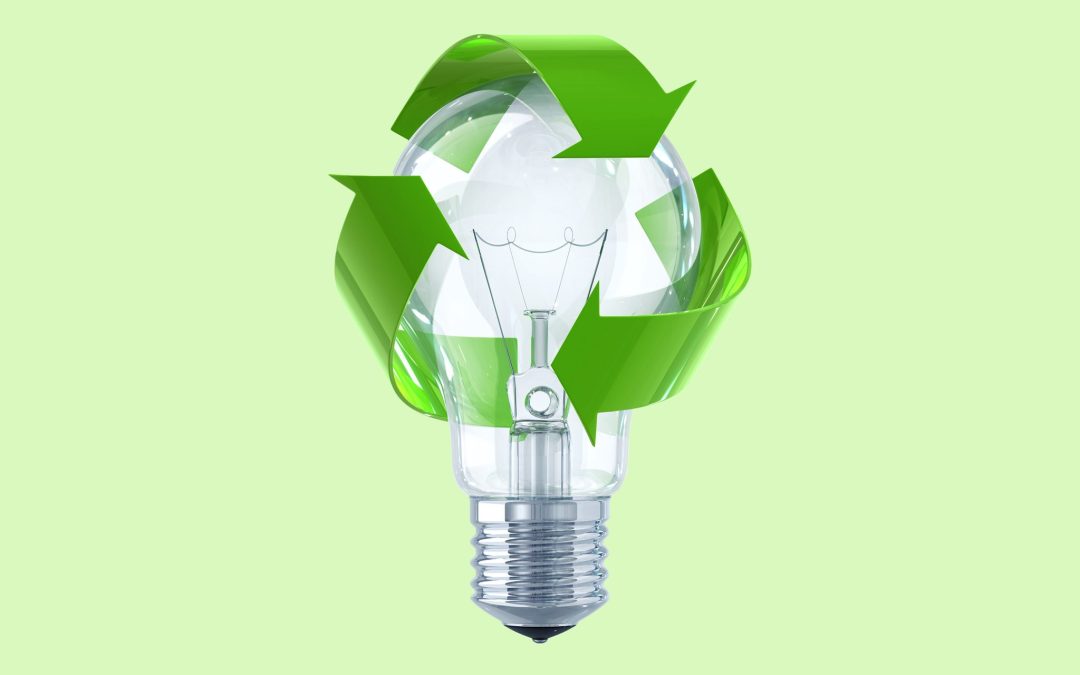All types of light bulbs are recyclable, even those that contain traces of mercury. In fact, some types of light bulbs must be recycled—when tossed in the trash, they leach environmentally harmful chemicals into the soil and groundwater.12
How to Recycle Light Bulbs
Each type of light bulb is recycled differently and each state and municipality has different requirements and recycling programs in place. While your curbside pickup recycling program may accept LED light bulbs, it typically will not take incandescent or CFL bulbs that may contain hazardous chemicals. Many states have specific recycling programs available for these materials.
Incandescent Light Bulbs
:max_bytes(150000):strip_icc():format(webp)/lamp-1056289908-fe850e6d9e2140328b168bcfba97a74d.jpg)
An incandescent light bulb consists of a glass enclosure containing a filament typically made from tungsten, a metal with a high melting point. When you turn an incandescent light bulb on, a current passes through the filament and heats it until it’s white-hot and produces visible light. Because they have a low manufacturing cost, work well on either alternating or direct electrical currents, and are compatible with devices like dimmers and timers, incandescent bulbs are popular for use in both household and commercial lighting. They’re often used in car headlamps and flashlights as well because they work both indoors and outdoors.
The bipartisan Energy Independence and Security Act of 2007 established efficiency standards that required bulbs to use about 25% less energy.3 While that didn’t necessarily ban incandescent bulbs, most were phased out of production. Today, incandescent bulbs are not as common as other types of light bulbs, but they aren’t unheard of. These types of light bulbs can be difficult to recycle because they contain small amounts of metal and glass that aren’t easily separated from one another. Many recyclers won’t accept incandescent light bulbs because the energy required to recycle them is not worth the salvaged material.
That said, you can find recycling programs that accept incandescent light bulbs with some digging. Check with the recycling facility near you to determine if they accept the material or consider a mail-in program. Incandescent bulbs are difficult to recycle, so you may have to resort to throwing your old ones away when you switch to a more efficient light source, like LED. They don’t contain any hazardous chemicals, but to minimize waste that reaches a landfill, avoid buying these types of bulbs.
Halogen Light Bulbs
:max_bytes(150000):strip_icc():format(webp)/low-angle-view-of-light-bulbs-mounted-on-ceiling-590116695-7b1118dc8db942b48a015deda7043cf3.jpg)
Although halogen light bulbs are primarily made of glass, you can’t put them in your glass recycling bin. Halogen light bulbs are made of quartz glass that melts at a different temperature than the bottles and jars in your bin. Including a halogen light bulb in your glass recycling bin could actually ruin an entire batch of glass recyclables.
Like incandescent bulbs, halogen bulbs are difficult to recycle because they contain fine wires. Many municipalities recommend that you throw halogen light bulbs in the trash instead of recycling them. That said, there are a few recyclers that accept halogen bulbs, but you’ll have to do some research to find one. There are a handful of mail-in recycling programs that will keep them out of the landfill.
CFLs
:max_bytes(150000):strip_icc():format(webp)/hand-installing-compact-florescent-light-bulb-185115334-d5a63d66e349471185aca9adc3090167.jpg)
Compact fluorescent light bulbs, or CFLS, are popular because they come in a variety of shapes and colors and they use less energy than incandescent bulbs. They’re the go-to bulbs for municipal buildings, schools, businesses, and hospitals across the world. When turned on, an electric current runs through a tube that contains argon and mercury and emits visible light.
While they are more energy-efficient than some other types of bulbs, CFLs aren’t necessarily environmentally friendly. CFLs contain mercury, which is toxic to humans and animals.
Because they are hazardous, these types of bulbs should not be thrown in the trash. Some municipalities even have laws against trashing your fluorescent bulbs, leaving recycling as the only option.
The EPA suggests that consumers take advantage of local CFL recycling programs rather than disposing of them along with household trash.2 Several retailers, including Bartell Drugs, Lowe’s, and Home Depot, accept CFL bulbs for recycling.
Once recycled, the glass, metals, and other materials in CFLs are reused to make new products. A bulb recycler uses special machines to extract mercury and break down the CFL’s glass casing and aluminum fixtures. They can reuse the mercury in new light bulbs or in products like thermostats. The glass becomes material like concrete or tile, while the aluminum is recycled as scrap metal.
Not only does recycling CFLs divert waste from the landfill, but it also prevents the release of toxic mercury into the environment. Contact your local waste collection agency for recycling options in your area.
What Do I Do if a CFL Breaks?
Broken CFLs can release mercury, which is a severe health hazard. When a CFL breaks, take the situation seriously. Immediately have all other people and pets leave the room so they can avoid exposure.
Open a window or door to the outside to air out the room for 5-10 minutes while you collect all broken glass and visible powder. Do not vacuum up the pieces because this could spread mercury-containing powder or vapor.
Place all broken glass and powder in a sealable container and check with your local government about disposal requirements.5
LED Light Bulbs
:max_bytes(150000):strip_icc():format(webp)/woman-holds-led-light-bulb-1331314452-45273008470b467c8a7c2346565de1bf.jpg)
A high-efficiency lighting option, light-emitting diode (LED) light bulbs produce light up to 90% more efficiently than incandescent bulbs.6 They’re more efficient than CFL bulbs, too. LED light bulbs can last up to 50,000 hours, which is about 30 times longer than incandescent bulbs and 5 times longer than a typical CFL.78
LED bulbs work by passing an electric current through a microchip, which then illuminates a light source to produce visible light. A heat sink absorbs any heat that the LEDs produce, so the bulbs won’t be hot to the touch.
With their long lifespan, lack of hazardous chemicals, and top-notch energy efficiency, LED light bulbs are the most eco-friendly bulbs on the market today.9 On top of that, they’re highly recyclable. Many big box stores like IKEA and Lowe’s have in-store recycling bins where you can drop off old LED bulbs. Some municipalities offer similar services. Contact your local waste management organization or a big box retailer near you to see if they accept them.
The first step in the recycling process is to send LED light bulbs through a shredder, which breaks its components apart. The individual glass and metal pieces are then processed through separators or magnetic sorters, depending on the facility. The metal components of LED lights are the most valuable, so that’s what most LED light recyclers are looking to salvage.
Ways to Reuse Light Bulbs
Before recycling your old light bulbs, consider ways you can reuse them—as long as they don’t contain harmful substances, you can give them new life with a little creativity.
It’s always a good idea to reuse an item before disposing of it to conserve Earth’s finite resources and to reduce waste. Light bulbs are surprisingly versatile, especially if you’re crafty. Here are a few ideas for reusing them:
- Fill it with soil and tiny plants to make a terrarium
- Use it to hold an air plant
- Fill the bulb with water to make a vase
- Turn it into a DIY snow globe
- Paint it and use it as a holiday ornament


